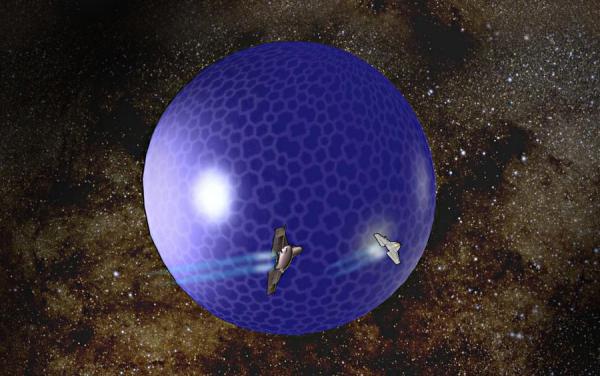BY LETTER
Tangaroa
Galactography > Regions of Space > Middle Regions/Hinter-regions
Galactography > Systems and Worlds > Systems & Worlds S - T
Galactography > Systems and Worlds > Systems & Worlds S - T
Artificial water-only planet | |
 Image from Steve Bowers | |
| Tangaroa is a vast ball of nearly pure water, encased in a transparent membrane designed to prevent evaporation | |
Star: JD 22321299
Type: K5V
2,870 light years from Sol (near HD 186569)
Planet: Tangaroa
Type: artificial watersphere
Diameter: 4862 km
Mass: 0.023 x Earth
Average Density: 1100 kg/m3 Pressure at Centre: approximately one gigapascal
Average Temperature: 293 K (core temperature 333 K)
Surface Gravity: 0.08 gees
Colonised: 7493 AT
The Panthalassan Ocean Fleet has colonised a large number of worlds in the Middle Regions and Outer Volumes, mostly in the expanse of space beyond the Aquila Rift, a region between the Orion Spur and the Sagittarius Arm with few bright stars. The larger part of the Ocean Fleet passed through the local Zoeific wormhole nexus until it reached its furthest extent and continued from there; much of this region was underdeveloped until the arrival of the Panthalassans.
JD 22321299 has two cold CryoJovian gas giants in its outer system, each of which has several large icy moons; the inner worlds are small and dry and of little interest to the water-dwelling Panthalassans. For a thousand standard years the Panthalassans stripped ice from three of the largest moons of the outermost planet Papatuanuku, using the strong magnetic field of the gas giant as a source of energy. This ice was used to fill a transparent spherical membrane with water, creating a waterworld heated from within by fusion-driven lamps known as 'photic cells'. By 8544 the new world, known as Tangaroa, had reached a diameter of 5350 kilometers; any larger and the pressure at the centre would be so great that high pressure ice would form.
This new world orbits deep within the powerful magnetic field of its primary, Papatuanuku; the water of this world provides excellent protection against the radiation emitted by particles trapped within this field. However the escape velocity of this light-weight world is very low, so the transparent membrane remains in place to prevent water loss. This means that the outer surface of the world has very little atmosphere, but is studded with landing ports and domed habitats where a population of nearbaseline humans can be found. When the surface-dwellers wish to venture into the depths of this world they must use suitably advanced technology to avoid being crushed by the extreme pressure.
At the very centre of this massive globe of water the temperature is 60 Celsius; here a small amount of carbon dioxide crystals collect as snow, since CO2 freezes at this temperature and pressure. This snow is used as a raw material by autofabs to produce consumer goods of various kinds.
The photic cells produce carefully regulated illumination for floating masses of geneered seaweeds, which produce oxygen and food for the waterdwellers. Between the photic cells there are vast volumes of lightless water, although most waterdwelling clades are capable of photoluminescence (which they use to locate one another and for low-bit-rate signalling). The photic cells each emit distinctive sonar signatures, or 'songs', to aid navigation in the dark waters.
Because of the gradual increase in pressure levels, Tangaroa is divided into several concentric zones each with its own distinct population. Denizens who are adapted to live at one level generally require biotech treatments before visiting other zones, and not all inhabitants are capable of adapting to levels very different from their own. Counting the large central volume, there are currently twelve distinct pressure levels in this artificial world.
Among the clades living in this globe are several species of provolved fish including Acties, a number of whale and dolphin species who have (like the humans) been extensively tweaked to be capable of breathing oxygenated water, and some radically tweaked xenoprovolves from the Lignosagittae phylum, who occupy some of the deepest levels. At the centre can be found a few experimental neogen clades and visitors from other levels who use advanced biotech, equally advanced hylotech or a synthesis of both to survive at such depths.
Recapitulationism
Human-derived water-breathers, including descendants of the Europan clade, are mostly confined to the outer three levels. Many of these human-derived swimmers are members of one or other of the local philosophical/religious cults which have developed from the teachings of Rhita Hrainert, one of the first inhabitants of the sphere (when it was much smaller). Hrainert taught that, since all life and the first stirrings of consciousness came from the sea, then by returning to the deep ocean and a contemplative existence a sophont can recapitulate the earliest stages of mentation. This creed, Recapitulationism, has developed into a full-blown religion, and has spread to several other Ocean Fleet worlds and beyond. In the deep, dark spaces of these ocean planets the devotees of recapitulation find a way to reflect on the deep, dark, infinite spaces of the Universe, and claim to start again at the bottom of the toposophic ladder, searching for new forms of mentality.Tangaroa has become a centre for advanced and esoteric psychological research, and several individuals from this world have become valued members of the Association for Interstellar Mental Health Monitoring, an organisation which has become increasingly active throughout the Middle Regions far from its origins in the Negentropy Alliance volume.
Related Articles
Appears in Topics
Development Notes
Text by Steve Bowers
Initially published on 26 October 2012.
Initially published on 26 October 2012.






